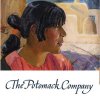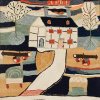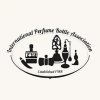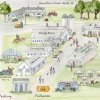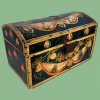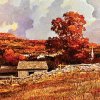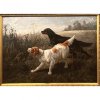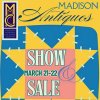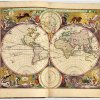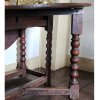Abolitionist Banner Leads at Evans Americana Sale
June 23rd, 2018
Jeffrey S. Evans & Associates, Mt. Crawford, Virginia
Photos courtesy Jeffrey S. Evans & Associates
Jeffrey S. Evans & Associates held its 34th semiannual Americana and fine antiques auction spotlighting Virginia and the South on June 22 and 23 at the firm’s gallery in Mt. Crawford, Virginia. We have become accustomed to these sales being exhaustingly long, but with a mere 850 lots, there was hope for a comparatively short day. Wrong! The categories of offerings consisted of the usual suspects: pottery, baskets, folk and fine art, silver, and ceramics. However, several of those categories were stretched to accommodate the number of lots slotted to be offered within them, and a slower-than-usual pace resulted in part from increased Internet bidding across the three platforms used by Evans.

The high lot of the sale was this antislavery banner. The image depicts an eagle surrounded by 23 irregularly positioned stars representing the nonsecessionist states. An inscription below the eagle reads “No Union with Slavery.” There are six black stripes on the 60" x 106" white cotton field. The stripes and the lettering appear to be paint or India ink; the eagle is stenciled with overall gray mottled coloring. The banner sold for $46,800 (est. $40,000/60,000). The winning bidder was York County, Pennsylvania, dealer Jeff Bridgman, who was bidding on the telephone. Additional information related to this lot is found in the accompanying report.

If family history is correct, this handsewn 17-star American national flag was witness to the action surrounding the American victory over the British on Lake Erie in September 1813. This flag is an unofficial rendition on the official flag of the day. It displays eight stripes and a wreath of 11 stars surrounding a large center star, with five additional individual stars in the canton field. The flag measures 32¼" x 67" and was presented in an archival frame. The flag displays areas of loss, repair, and considerable wear. It sold for $23,400 (est. $10,000/15,000).
One of the larger groups of lots consisted of 37 flags and banners. A majority of those lots were from the collection of a single consignor. All examples in the group were American national flags or some variation thereof, or political campaign flags, with a few Confederate flags thrown in. The high lot of the day came from among the flags and banners. A large antislavery banner, custom framed to 71" x 116¼", took top honors, selling to York County, Pennsylvania, dealer, Jeff Bridgman for $46,800 (includes buyer’s premium) against an estimate of $40,000/60,000. The banner itself is described among the photos accompanying this report.
The antislavery banner had emerged into public view on an episode of the PBS show History Detectives in 2004. It is believed that the banner had been used at an abolitionist convention in Rochester, New York, in January 1861. The wording on the banner, “No Union with Slavery,” is thought to have been inspired by William Lloyd Garrison’s motto, “No Union with Slaveholders.” Garrison (1805-1879) was a leading figure in the abolitionist movement, using his newspaper, the Liberator, as a voice to further the cause. In the catalog notes, Jeff Evans describes the banner as “An important [survivor] from a turbulent period in our country’s past....”
Bridgman was an active buyer, winning not only the antislavery banner but also several other flag lots, including a Henry Clay presidential campaign banner for $26,910 and a handsewn 31-star flag commemorating California’s 1850 admission to the Union for $15,210. Both lots closed at nearly double their high estimates.
 Another large run of lots was composed of 80 individual maps and atlases, 57 of which had been deaccessioned by the Colonial Williamsburg Foundation, Williamsburg, Virginia. All proceeds from the sale of those lots were earmarked to benefit the foundation’s Collections Acquisition Fund. The maps sold well, but the pace was noticeably slower than anyone had expected.
Another large run of lots was composed of 80 individual maps and atlases, 57 of which had been deaccessioned by the Colonial Williamsburg Foundation, Williamsburg, Virginia. All proceeds from the sale of those lots were earmarked to benefit the foundation’s Collections Acquisition Fund. The maps sold well, but the pace was noticeably slower than anyone had expected.

This paint-decorated pine box is the most recent member of the Stirewalt group of boxes to be offered at auction. The box dates circa 1840, and it descended directly through the family of its original owner. The box is one of the smallest of the group, measuring only 6¾" x 10 3/8" x 6". Its surface is decorated with eight-point stars, feather-like designs, and what the catalog describes as “opposing geese” on the lid, all on a deep green ground. The case is dovetailed, the bottom is face nailed to the case, and the turned feet are ebonized. The box sold to a telephone bidder for $38,025 (est. $10,000/15,000). Additional information on this box is found in the accompanying report.
The highlight within the folk art category came as no surprise. On several occasions we have reported of the sales of a specific group of painted boxes and miniature chests from Virginia’s Shenandoah Valley. Those chests and boxes are referred to as members of the “Stirewalt group.” (See M.A.D., January 2008, p. 14-C; M.A.D., October 2011, p. 11-A; and M.A.D., June 2017, p. 23-B.) Yet another member of the group was offered at the Evans sale. The box was fresh to the market and a representative example of the smallest members of the group, measuring only 6 3/4" x 10 3/8" x 6". (Picture a small loaf of bread with short legs.) Constructed of yellow pine, the paint-decorated box was raised on turned ebonized feet. It had a lock and remnants of the original leather hinges. This Stirewalt box sold to one of several telephone bidders for $38,025 (est. $10,000/15,000). See accompanying photos for additional information.

This carved and polychrome-painted cedar totem pole is from the indigenous Haida peoples of the Pacific Northwest. The Haida live on Haida Gwaii, British Columbia, an island approximately halfway between Vancouver, British Columbia, and Juneau, Alaska. The totem pole is carved with three animal figures and dates from the late 19th or early 20th century. It measures 29¾" high. Spirited bidding pushed the final price to $19,890 (est. $300/500).

This 12-tin food safe is constructed of poplar with yellow pine as its secondary wood. The tins are punched with an elaborate pattern featuring corner fans, a central eight-point star, a chain border, and the initials “J” and “M” incorporated into the design of each tin. The maker may have been James McCann of New Market, Virginia. The case is raised on tall tapered square-section legs. The surface displays old green paint over the original Spanish brown surface. The circa 1815 safe, 65½" x 40" x 18", sold in the room for $4680 (est. $3000/5000).

This paint-decorated jelly cupboard was fresh from a Cleveland County, North Carolina, estate. The yellow pine cupboard has picture-frame molding applied to the case and the doors. The interior has two fixed shelves. The case is raised on arched feet cut into the end panels. The surface is red-washed, and both the doors and end panels are painted with intertwined flowering vines. The doorframe is decorated with similar vine elements. The 56½" x 39" x 18" cupboard from the fourth quarter of the 19th century sold for $10,530 (est. $3000/5000).

The J.S. Blazier was an 87-ton tug based out of Toledo, Ohio. This oil on canvas portrait of the vessel is by Great Lakes maritime painter Howard Freeman Sprague (1871-1899). The painting depicts the tug under power in choppy water, with a darkening sky and sailboats in the background. The 16½" x 29?" painting dates circa 1895 and is signed lower right. It sold for $7020 (est. $3000/5000).
Study of the Stirewalt group of boxes is ongoing. Bits of new information are often gleaned from each newly identified example. J. Roderick Moore and Marshall Goodman are recognized as the leading scholars on the subject. Their article “The Stirewalt group,” published in the September 2007 issue of The Magazine Antiques, established the group and set in motion much of the scholarship associated with it. Following the sale of the box at the Evans sale, I asked Marshall Goodman for his reaction. He was pleased but offered an interesting comment as an aside. He said, “Of course, the lock [on this box] was added later.... What good does a lock do, if you have leather hinges?” There is another nugget to add to the pile.
For additional information, contact Jeffrey S. Evans & Associates at (540) 434-3939 or (www.jeffreysevans.com).

This simple tilt-top mahogany Queen Anne candlestand from eastern Virginia is from the fourth quarter of the 18th century. The top is a single board, and the pedestal is a tapered column with a single decorative ring. The cabriole legs terminate in snake-head feet. The stand retains its original wrought-iron reinforcing “spider” leg brace. The near-pristine condition of the stand translated into intense bidding from all quarters, pushing the price to $7605 (est. $500/800).

This American school portrait dates circa 1730 and is thought to be the likeness of Joseph Kellogg of New York and Massachusetts (1691-1756). Kellogg was an early settler, merchant, and trader and interpreter among Native American tribes in New England and Canada. The 32" x 24" (sight size) portrait is unsigned and was presented in a wide painted frame with gilt molded decoration. The painting prompted a bidding duel between an Internet bidder and a prominent dealer in the room. The Internet bidder won, paying $8190 (est. $300/500).

This salt-glazed stoneware pitcher is stamped “J. Miller.” James Miller was an active potter in Alexandria, Virginia, and Georgetown (District of Columbia) during the first quarter of the 19th century. Articles stamped with only Miller’s initial and surname are quite rare. The approximately one-gallon capacity ovoid pitcher is boldly decorated with a horizontal brushed cobalt floral design. The pitcher has a strap handle and stands 10½" high. It sold for $3276 (est. $1000/1500).

This face of this mahogany wall mirror clock by Joseph Ives is lettered “Joseph Ives / Brooklyn, NY,” which dates the clock 1825-30. The clock measures 65½" high overall, and it sold for $17,550 (est. $500/800).

This woven splint basket tray is an excellent example of Wythe County, Virginia, basket making. The 15½" long form exhibits converging rib construction, with an arched forked handle and a double wrapped rim. The late 19th- or early 20th-century basket retains an old, possibly original, varnished surface and sold for $3393 (est. $800/1200).

This walnut tall-case clock, 94" high overall, is by Caleb Davis (1769-1834) of Woodstock, Virginia, and dates circa 1810. The bell-chime movement is brass. The face is sheet iron, painted with floral spandrels and an urn above the chapter ring. The calendar dial features Roman numerals, with Arabic numerals at the quarter-hour. Davis’s name is inscribed on the face. The dovetailed hood displays a broken arch set with three vasiform finials and a tombstone door flanked by turned columns. The waist section features a shaped panel door; the base rests on applied bracket feet. The clock sold in the room for $15,210 (est. $8000/12,000).

Here is a carved rosewood Rococo Revival center table attributed to the New York City firm J. & J. W. Meeks. The heavily carved table features a marble turtleback insert over a carved and pierced apron featuring grape clusters and roses. The serpentine legs continue the carving and are joined by an X-stretcher centered with a large carved basket of flowers. The circa 1860 high-style table, 32" x 43½" x 27¾", brought $16,380 (est. $10,000/15,000).
Originally published in the September 2018 issue of Maine Antique Digest. © 2018 Maine Antique Digest
